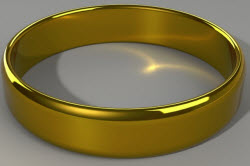When light refracts through or reflects off of a surface, these bent rays are focused together, creating a bright pattern referred to as a caustic.
| Refractive Caustic |
Reflective Caustic |
|---|
 |
 |
| The light refracts through the wine glass. |
The light reflects off the gold ring. |
In addition to reflective and refractive, there are two other types of caustics:
|
Indirect caustics
|
Caustics created by indirect lighting (scene illumination).
|
Indirect refractive caustics are always on in SOLIDWORKS.
|
Indirect reflective caustics are always off in SOLIDWORKS.
|
|
Direct caustics
|
Caustics created by direct lighting, including spot or point lights.
|
Directional lights do not affect direct or indirect caustics.
Direct caustics are only visible when reflected off a floor appearance or real geometry. To turn on direct caustics, click and use the PropertyManager. Direct caustics are only visible in the final render image.